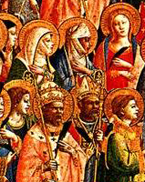
Joseph René Vilatte
The New World could hardly have a more suitable apostle of ancient Christianity than Joseph René Vilatte. His background, his restlessness and marginality, even what many would call his rascality, all are in the tradition of Our Lord, of Peter and Paul, and of Thomas, who could be called the most vagrant of episcopi vagantes. He has aptly been described by his biographer Serge Thériault as a "community organizer of religion." European by birth (and in his death), his eclectic approach, exemplified by the number of Christian bodies he associated with in his formative years of ministry, and his individualism were perfectly suited to the New World where he spent most of his active life, first in Canada and later in the United States (and for a brief time in Mexico as well). He was like many North Americans of his generation, immigrant or native-born, not least in his returns to the Old World to seek validation.

The future Mar Timotheus was born in Paris on January 24, 1854 (or 1855 according to some sources). His parents reportedly were members of a small independent church, one of several collectively referred to as "la Petite Eglise." One wonders how this may have conditioned his adult attitudes toward the nature of church power and authority.
The Vilattes came from the region of Maine in the middle Loire valley, where the descendants of "la Petite Eglise" continue to live and worship quietly, almost invisibly. This movement was opposed equally to the secularization of the church by the Constitution of the Clergy in 1792 and to the Concordat of 1801, both of which in different ways placed the church firmly under the control of the state. By the time Vilatte was born, the bishops and priests who had led "the Little Church" in its early decades had all died. The laity continued to worship, although the only sacrament they had was baptism. One source [http://www.hpb.asso.fr/La-Petite-Eglise.html] even reports that women were permitted to lead worship, citing a Thérèse Drochon who did so at Cirières around 1850.
Orphaned early, he was raised a Roman Catholic by the Brothers of the Christian Schools. He made his first trip to Canada around 1870, after living through the violence of the Franco-Prussian War and the Paris Commune, and taught school there. He returned to France but faced with a draft notice, he left for Belgium. In 1876 he returned to Canada and began studying for ordination for the Diocese of Montreal when he came under the influence of Charles Chiniquy, who was then one of the most prominent "ex-Catholic" polemicists and lecturers in North America. At Chiniquy's behest (after a brief reconciliation to Rome took him to Bourbonnais, Illinois) he went to Wisconsin in 1884, there to minister to Belgian and French-Canadian immigrants in the Green Bay area who had left the Roman communion. At first he worked under the auspices of the Presbyterians, but finding his flock no more inclined to Protestantism than to Romanism, he made a loose agreement with the Episcopal bishop of Fond du Lac, Hobart Brown, with the idea of forming an "Old Catholic" parish under the Episcopal Church's aegis.
This proposal was very much in the spirit of the times. Episcopalians in the United States were very much interested in closer ties both to the Old Catholics of Europe (under the primacy of the Archbishop of Utrecht) and to the Eastern Orthodox Churches. The former were churches that traced their independence to the early 1700s, disagreeing with Rome's handling of the Jansenist controversy. Their numbers and geographic spread grew dramatically after the First Vatican Council promulgated the dogma of papal infallibility in 1870, when former Roman Catholics who did not accept this innovation turned to Utrecht for an ecclesiastical home. This would result in the Union of Utrecht of Old Catholic Churches, established in 1889. (Sharing much with the Anglican Communion, the Union of Utrecht entered into intercommunion with Anglicans worldwide in 1931.) At the same time, American Episcopalians of high-church sympathies were promoting the idea that the Church of England and its daughters were, essentially, an English Orthodox Church parallel to those of Russia, Greece, and so on.




